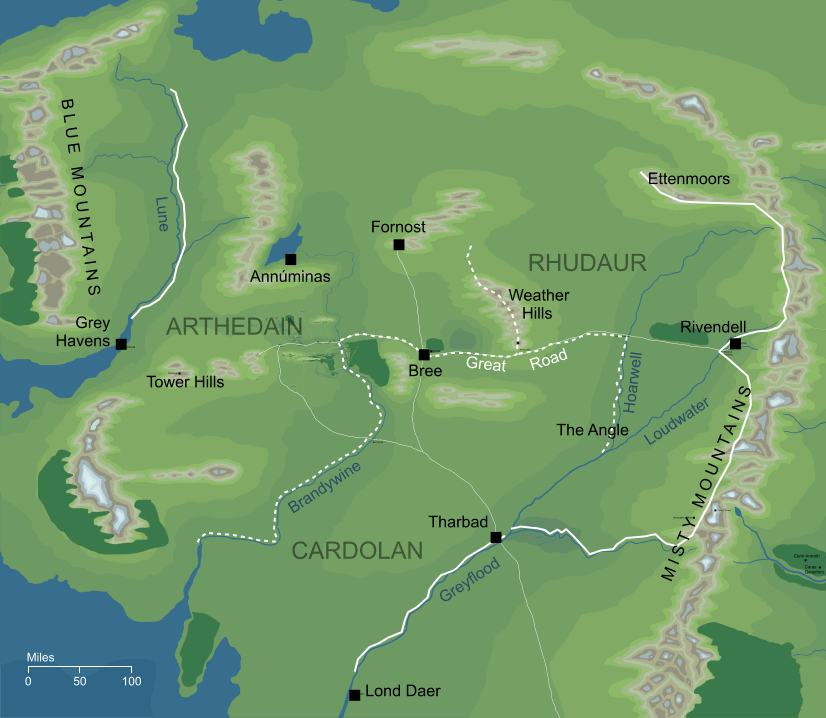
The Lost Realm of
Arnor. The solid white lines represent the known borders of the realm, while the dashed lines show the approximate borders of its three successor kingdoms,
Arthedain,
Cardolan and
Rhudaur.
The Lost Realm of
Arnor. The solid white lines represent the known borders of the realm, while the dashed lines show the approximate borders of its three successor kingdoms,
Arthedain,
Cardolan and
Rhudaur.
Founded in the closing years of the Second Age, Arnor was at first the seat of the High King of the Dúnedain in Middle-earth. Annúminas on the lake of Nenuial was the royal city in the North, from which Elendil ruled both the North-kingdom and (through his sons) the South-kingdom of Gondor. It remained the pre-eminent state of the Dúnedain for more than a century, but after both Elendil and Isildur his heir were lost, Arnor was left with a King who was no more than a child, and Gondor in the south became an independent realm.
Though it no longer ruled over Gondor, the North-kingdom survived as a realm for nearly nine further centuries. It was after the death of its last King, Eärendur, that Arnor became the Lost Realm; Eärendur's sons fell into dispute over his inheritance, and the land was divided into three parts. It was in the westernmost of these, Arthedain, that Eärendur's true heir Amlaith ruled, so while Arnor itself had been lost, the line of its Kings survived to rule a lesser land.
The new land of Arthedain survived longer than its predecessor Arnor, but much of its history was filled with warfare. In the time of its sixth King, Malvegil, the land of Angmar emerged to the east, and from that time Arthedain fought a long war against the Witch-king that lasted nearly seven hundred years. In the year III 1974, Arthedain's capital of Fornost was overrun by the Witch-king, and the last surviving vestige of the old High Kingdom of the Dúnedain was truly lost.
At the time of the War of the Ring, these events lay more than a thousand years in the past, and the realm that had once ruled all the Dúnedain of Middle-earth lay in desolation and ruin, and was remembered only as the Lost Realm of Arnor.
Notes
1 |
Annúminas and Fornost were the chief cities of the Dúnedain in this region, but there were many other settlements within the realm that were not directly connected with the Dúnedain. Most important of these was probably Bree, which lay at the central crossroads of the old North-kingdom. Hobbits migrating from there had founded the Shire within the lands of Arthedain before that kingdom met its end.
The city of Tharbad that lay on Arnor's southern border was not properly part of Arnor itself; rather, it was jointly maintained with Gondor as part of the ancient route that ran between the Two Kingdoms.
|
Indexes:
About this entry:
- Updated 29 October 2019
- Updates planned: 2
For acknowledgements and references, see the Disclaimer & Bibliography page.
Original content © copyright Mark Fisher 2013, 2016-2017, 2019. All rights reserved. For conditions of reuse, see the Site FAQ.

